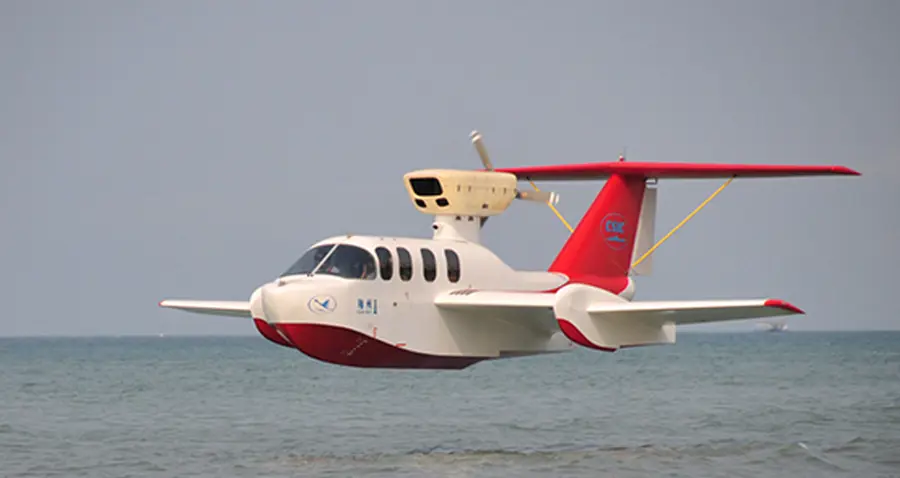

Do you get seasick on a boat and have a fear of flying? Worry no more. In the future, we may all be travelling in so called WIGs (Wing In Ground), or flying boats. By harnessing the lift generated by flying close to the water surface, WIGs are able to travel at 200 210 km/h and up to 150m above the sea level with only a third of the fuel consumption associated with modern planes. After two decades of product development by different nations, these oddities are starting to be considered for commercial flights (or should we say cruises?). One of the pioneers is CSIC (Hainan) Wig Craft Development in China that builds state-of-the-art WIGs using DIAB core material.
In between a boat and a plane
A WIG craft is more or less a boat that cruises just above the water surface (around 15 m above the sea), thereby reducing hydrodynamic drag to a minimum. By flying so close to the surface, the WIG generates a cushion of air that it rides on, using much less fuel than ordinary aircraft. It does not require fixed runways and is exceptionally safe and friendly to the environment due to low use of energy and exchange of fluids with the sea.
The WIG-technique was actually first used by the Wright brothers when they flew their first aircraft ‘The Flyer’ in 1903. It was later applied by the Russians, who also hold the record for building the largest WIG ever – the 540 ton Caspian Sea Monster with a wing span of 40 m that was capable of skimming just meters above the sea at speeds of up to 500 km/h.
Divinycell-cored WIGs from China
Today’s WIGs are generally much smaller. The Chinese manufacturer CSIC (Hainan) Wig Craft Development specializes in the development of WIGs that can carry maximum 7 people, including the pilot, and have a range of 400 km. Allowing the passengers to combine the excitement of a high speed boat with the convenience of an aircraft, they could be perfect for transportation among the small islands in South China Sea.
For all main structures of the boat, CSIC (Hainan) Wig Craft Development uses Diab’s Divinycell H80, which reduces weight by 15% compared to traditional monolithic structure, increases load capacity and improves structure stiffness and sound/heat insulation. H80 helps the whole structure of WIG to withstand the dynamic load such as water impact load during the taking off and landing from and onto the water surface.
Divinycell H80 also increases the buoyancy of the WIG, which means the boat can float even if it becomes damaged.
The future of maritime transportation?
The potential for WIG craft is enormous, whether it is in the South China Sea, the North Sea, in wide regions of the Mediterranean, between the Greek islands or in Maldives. The passengers save a lot of valuable time boarding in the heart of the coast cities, instead of travelling to an airport. There are also huge prospects for military applications, since the WIG can avoid radar and sonar scans. So who knows, perhaps we are witnessing the start of a new chapter in maritime transportation?
Read more about Divinycell H80 and other Diab core materials
For more information about CSIC (Hainan) Wig Craft Development, please visit http://www.wigcraft.cn/
For general information about ground effect vehicles, visit Wikipedia,
http://en.wikipedia.org/wiki/Ground_effect_vehicle

Do you get seasick on a boat and have a fear of flying? Worry no more. In the future, we may all be travelling in so called WIGs (Wing In Ground), or flying boats. By harnessing the lift generated by flying close to the water surface, WIGs are able to travel at 200 210 km/h and up to 150m above the sea level with only a third of the fuel consumption associated with modern planes. After two decades of product development by different nations, these oddities are starting to be considered for commercial flights (or should we say cruises?). One of the pioneers is CSIC (Hainan) Wig Craft Development in China that builds state-of-the-art WIGs using DIAB core material.
In between a boat and a plane
A WIG craft is more or less a boat that cruises just above the water surface (around 15 m above the sea), thereby reducing hydrodynamic drag to a minimum. By flying so close to the surface, the WIG generates a cushion of air that it rides on, using much less fuel than ordinary aircraft. It does not require fixed runways and is exceptionally safe and friendly to the environment due to low use of energy and exchange of fluids with the sea.
The WIG-technique was actually first used by the Wright brothers when they flew their first aircraft ‘The Flyer’ in 1903. It was later applied by the Russians, who also hold the record for building the largest WIG ever – the 540 ton Caspian Sea Monster with a wing span of 40 m that was capable of skimming just meters above the sea at speeds of up to 500 km/h.
Divinycell-cored WIGs from China
Today’s WIGs are generally much smaller. The Chinese manufacturer CSIC (Hainan) Wig Craft Development specializes in the development of WIGs that can carry maximum 7 people, including the pilot, and have a range of 400 km. Allowing the passengers to combine the excitement of a high speed boat with the convenience of an aircraft, they could be perfect for transportation among the small islands in South China Sea.
For all main structures of the boat, CSIC (Hainan) Wig Craft Development uses Diab’s Divinycell H80, which reduces weight by 15% compared to traditional monolithic structure, increases load capacity and improves structure stiffness and sound/heat insulation. H80 helps the whole structure of WIG to withstand the dynamic load such as water impact load during the taking off and landing from and onto the water surface.
Divinycell H80 also increases the buoyancy of the WIG, which means the boat can float even if it becomes damaged.
The future of maritime transportation?
The potential for WIG craft is enormous, whether it is in the South China Sea, the North Sea, in wide regions of the Mediterranean, between the Greek islands or in Maldives. The passengers save a lot of valuable time boarding in the heart of the coast cities, instead of travelling to an airport. There are also huge prospects for military applications, since the WIG can avoid radar and sonar scans. So who knows, perhaps we are witnessing the start of a new chapter in maritime transportation?
Read more about Divinycell H80 and other Diab core materials
For more information about CSIC (Hainan) Wig Craft Development, please visit http://www.wigcraft.cn/
For general information about ground effect vehicles, visit Wikipedia,
http://en.wikipedia.org/wiki/Ground_effect_vehicle
